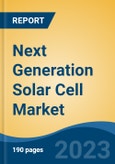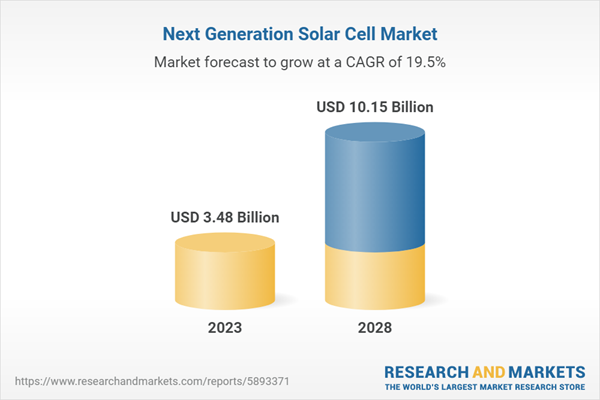Free Webex Call
The Global next generation solar cell market is predicted to develop at a rapid pace throughout the forecast period. The growth of the market is driven by the increasing demand for renewable energy, growing energy crisis, and government support. Materials used in next-generation solar cells include cadmium telluride (CdTe), copper indium gallium selenide (CIGS), amorphous silicon, and gallium-arsenide. These materials outperform silicon-based cells in terms of efficiency and natural and artificial light performance. A next-generation solar cell has a thickness of less than one micron and can be made at low temperatures utilizing low-cost methods such as printing. Speak directly to the analyst to clarify any post sales queries you may have.
10% Free customizationThis report comes with 10% free customization, enabling you to add data that meets your specific business needs.
Several types of next-generation solar cells are gaining market traction, organic solar cells, perovskite solar cells, dye-sensitized solar cells, quantum dot solar cells, and multi-junction solar cells are certain examples. Each of these technologies offers distinct advantages such as increased efficiency, flexibility, lightweight, and lower manufacturing costs, making them suitable for a wide range of applications. The global market for next-generation solar cells is undergoing tremendous research and development. Scientists and engineers are constantly attempting to tackle the obstacles that these developing technologies present, including stability, scalability, and commercial feasibility. Ongoing research aims to improve the performance of next-generation solar cells, extend their lifespan, and lower manufacturing costs to make them more competitive with traditional solar cells.
The market for next-generation solar cells is expected to rise. Demand for advanced solar cell technology is predicted to rise as investments in renewable energy infrastructure increase and government policies encouraging clean energy adoption improve. Furthermore, falling production costs for next-generation solar cells, along with increased economies of scale, will likely fuel industry expansion in the future years. Finally, the global market for next-generation solar cells is seeing tremendous developments and expansion. These cutting-edge solar cell technologies provide increased efficiency, higher performance, and new opportunities for capturing solar energy. As the world moves towards a more sustainable energy future, next-generation solar cells will be critical in addressing the growing worldwide need for clean and renewable energy.
Increasing Demand for Clean and Sustainable Energy
The rising demand for clean and sustainable energy is a primary driver of the global next-generation solar cell market's expansion. To prevent the effects of climate change, there has been a global movement in recent years to transition away from fossil fuels and reduce greenhouse gas emissions. The transition to a low-carbon economy has increased the demand for renewable energy sources, with solar power emerging as a critical component of the clean energy mix. As a clean and sustainable energy source, solar energy has various advantages. It is plentiful, readily available, and has a low environmental impact when compared to typical fossil fuel-based power generation. With their increased efficiency and improved performance, next-generation solar cells are well-suited to fulfil the expanding global energy demands.The need to combat climate change is one of the key drivers of demand for clean energy. The combustion of fossil fuels for energy generation emits greenhouse gases, which contribute to global warming and climate-related disruptions. Renewable energy sources, such as solar power, provide a potential answer for lowering carbon emissions and mitigating climate impacts. With their increased efficiency, next-generation solar cells can generate more power from the same quantity of sunlight, resulting in lower carbon emissions.
Furthermore, the need for renewable energy sources is being driven by the need for energy security. Many countries rely significantly on imported fossil fuels, which creates economic issues and exposes them to supply disruptions and price changes. Nations can improve their energy security and lessen their reliance on external energy sources by investing in solar power and using next-generation solar cells. The worldwide commitment to sustainable development, as embodied in the United Nations Sustainable Development Goals (SDGs), is a major driver of clean energy adoption. Governments, corporations, and individuals are increasingly recognizing the significance of shifting to renewable energy sources to accomplish the SDGs, which include affordable and clean energy, climate action, and sustainable cities and communities. Finally, rising demand for clean and sustainable energy is a major driver of the global next-generation solar cell market. The urgent need to battle climate change, maintain energy security, and meet sustainable development goals, as well as government assistance through laws and incentives are significant reasons pushing solar power use and the evolution of next-generation solar cells. These modern solar cell technologies, with their increased efficiency and improved performance, are well-positioned to fulfil the world's increasing energy demand while lowering greenhouse gas emissions and encouraging a more sustainable future.
Energy Security and Independence
Energy security and independence are critical aspects driving demand for the global market for next-generation solar cells. Solar power and its modern technologies offer major benefits that contribute to energy security as governments attempt to assure a reliable and self-sufficient energy supply.Technological Advancements
Organic solar cells, perovskite solar cells, and quantum dot solar cells are examples of next-generation solar cell technologies that have seen substantial scientific developments in recent years. These developments have enhanced efficiency, durability, and scalability, making them more suitable for large-scale deployment and commercialization. Technological improvements are critical in fueling the growth and demand for next-generation solar cells. As researchers and scientists make substantial advances in upgrading solar cell technology, their efficiency, performance, and commercial viability improve, hastening their adoption and market expansion.One of the most important areas of technical improvement is the creation of novel materials for next-generation solar cells. Traditional silicon-based solar cells have efficiency and cost-effectiveness limits. However, advances in materials science have resulted in the development of new materials such as perovskites, organic compounds, and quantum dots. These materials have improved light absorption, charge transport properties, and manufacturing costs, allowing for the development of more efficient and affordable solar cells. Advances in materials science have resulted in the development of new materials such as perovskites, organic compounds, and quantum dots. These materials have improved light absorption, charge transport properties, and manufacturing costs, allowing for the development of more efficient and affordable solar cells. Furthermore, advances in allied domains such as nanotechnology, photonics, and material characterization techniques aid in the creation of next-generation solar cells. These interdisciplinary collaborations aid in the discovery of new insights and opportunities for increasing solar cell performance, efficiency, and durability.
Finally, technological developments are significant drivers of the next-generation solar cell market's growth. Scientists and engineers are constantly developing solar cell technology through research and development activities, making them more efficient, cost-effective, and reliable. These advances in materials, manufacturing techniques, energy storage, and related sectors are accelerating the adoption of next-generation solar cells and paving the way for a sustainable and clean energy future.
Market Segmentation
The next generation solar cell market can be segmented by material type, installation type, end-user, and region. Based on material type, the market is segmented into cadmium telluride (CdTe), copper indium gallium selenide (CIGS), amorphous silicon, gallium-arsenide, and others. Based on installation type, the market is segmented into on-grid and off-grid. Based on end-user, the market is segmented into utilities, residential, commercial, and industrial. The market analysis studies the regional segmentation among North America, Europe, Asia-Pacific, South America, and Middle East & Africa.Company Profiles
Heliatek GmbH, Polysolar Ltd, 3D-Micromac AG, Suntech Power Holdings Co., Ltd, Eaton Corporation, Schneider Electric SE, Spirae, LLC, Schweitzer Engineering Laboratories (Sel), Electrical Transient Analyzer Program, and S&C Electric Company., are among the major players that are driving the growth of the global next generation solar cell market.Report Scope:
In this report, the global Next Generation Solar Cell market has been segmented into the following categories, in addition to the industry trends which have also been detailed below:Next Generation Solar Cell Market, By Material type:
- Cadmium telluride (CdTe)
- Copper indium gallium selenide (CIGS)
- Amorphous silicon
- Gallium-arsenide
- Others
Next Generation Solar Cell Market, By Installation Type:
- On-grid
- Off-grid
Next Generation Solar Cell Market, By End-User:
- Utilities
- Residential
- Commercial
- Industrial
Next Generation Solar Cell Market, By Region:
- Asia-Pacific
- China
- Japan
- India
- Australia
- South Korea
- North America
- United States
- Canada
- Mexico
- Europe
- United Kingdom
- Germany
- France
- Spain
- Italy
- Middle East & Africa
- Israel
- Turkey
- Saudi Arabia
- UAE
- South America
- Brazil
- Argentina
- Colombia
Competitive Landscape
Company Profiles: Detailed analysis of the major companies present in the global Next Generation Solar Cell market.Available Customizations:
With the given market data, the publisher offers customizations according to a company’s specific needs.This product will be delivered within 1-3 business days.
Table of Contents
1. Product Overview
2. Research Methodology
5. Global Next Generation Solar Cell Market Outlook
6. North America Next Generation Solar Cell Market Outlook
7. Asia-Pacific Next Generation Solar Cell Market Outlook
8. Europe Next Generation Solar Cell Market Outlook
9. South America Next Generation Solar Cell Market Outlook
10. Middle East & Africa Next Generation Solar Cell Market Outlook
11. Market Dynamics
13. Company Profiles
15. About the Publisher & Disclaimer
Companies Mentioned
- Heliatek GmbH
- Polysolar Ltd
- 3D-Micromac AG
- Suntech Power Holdings Co., Ltd
- Eaton Corporation
- Schneider Electric SE
- Spirae, LLC
- Schweitzer Engineering Laboratories (Sel)
- Electrical Transient Analyzer Program
- S&C Electric Company
Table Information
| Report Attribute | Details |
|---|---|
| No. of Pages | 190 |
| Published | October 2023 |
| Forecast Period | 2023 - 2028 |
| Estimated Market Value ( USD | $ 3.48 Billion |
| Forecasted Market Value ( USD | $ 10.15 Billion |
| Compound Annual Growth Rate | 19.5% |
| Regions Covered | Global |
| No. of Companies Mentioned | 10 |









